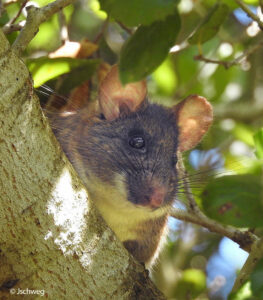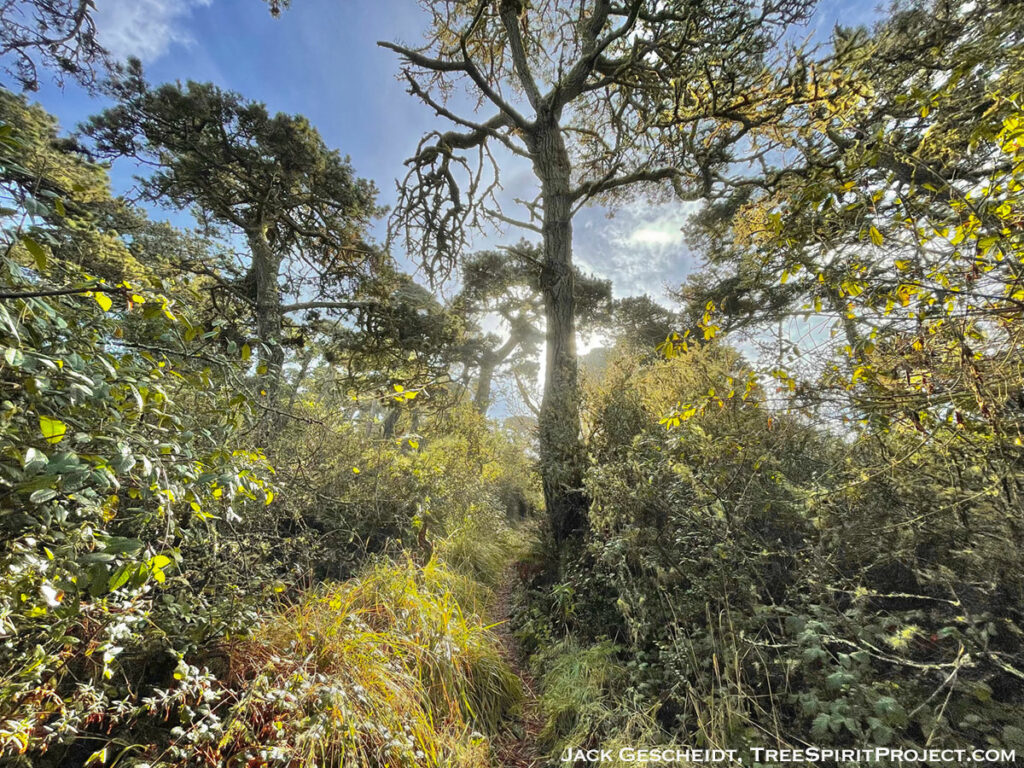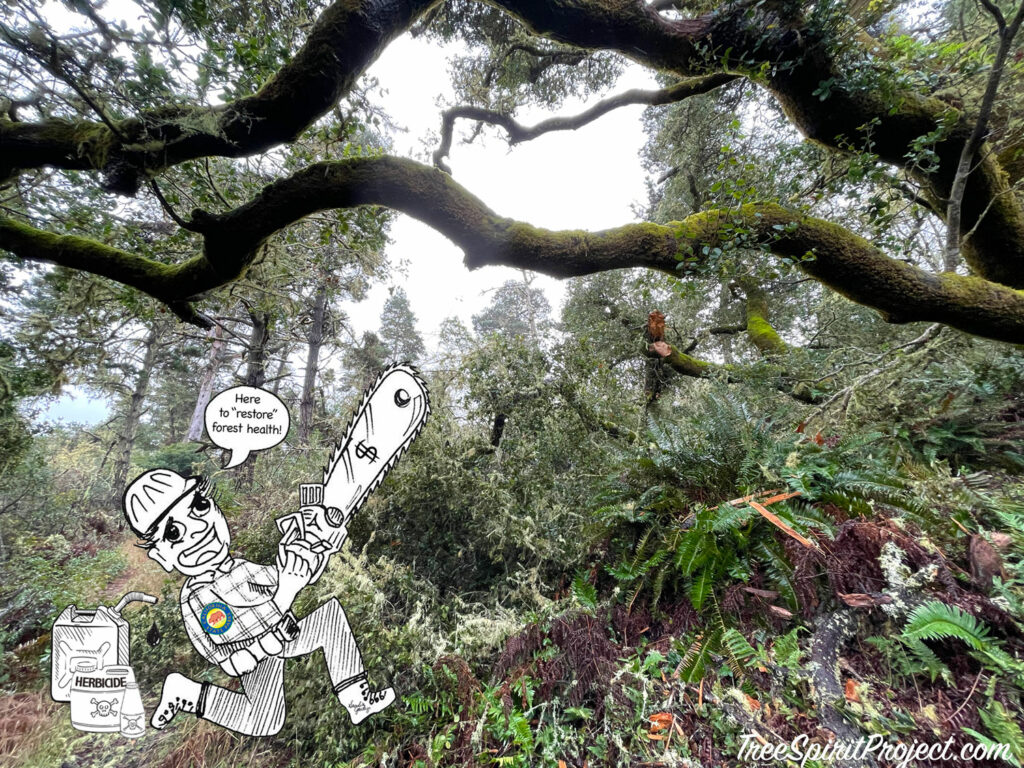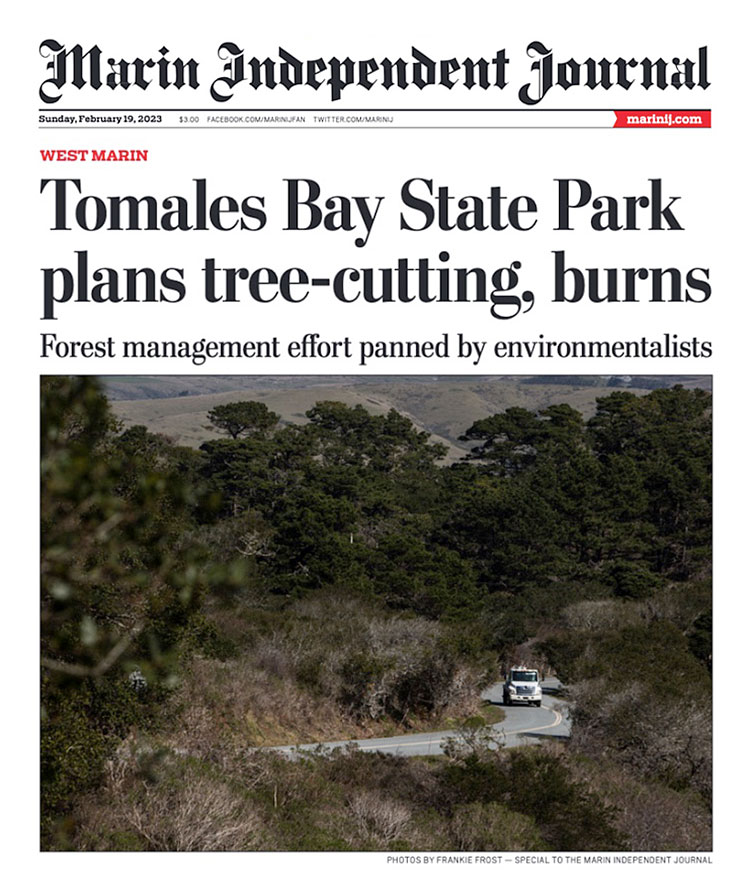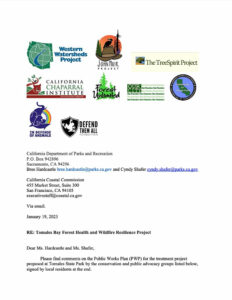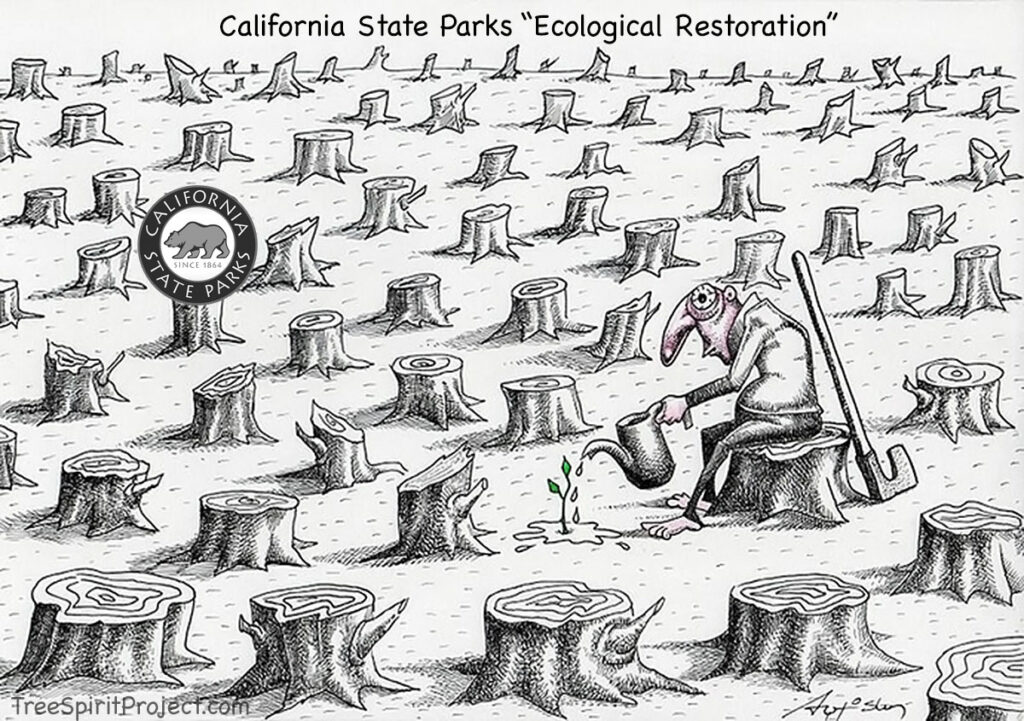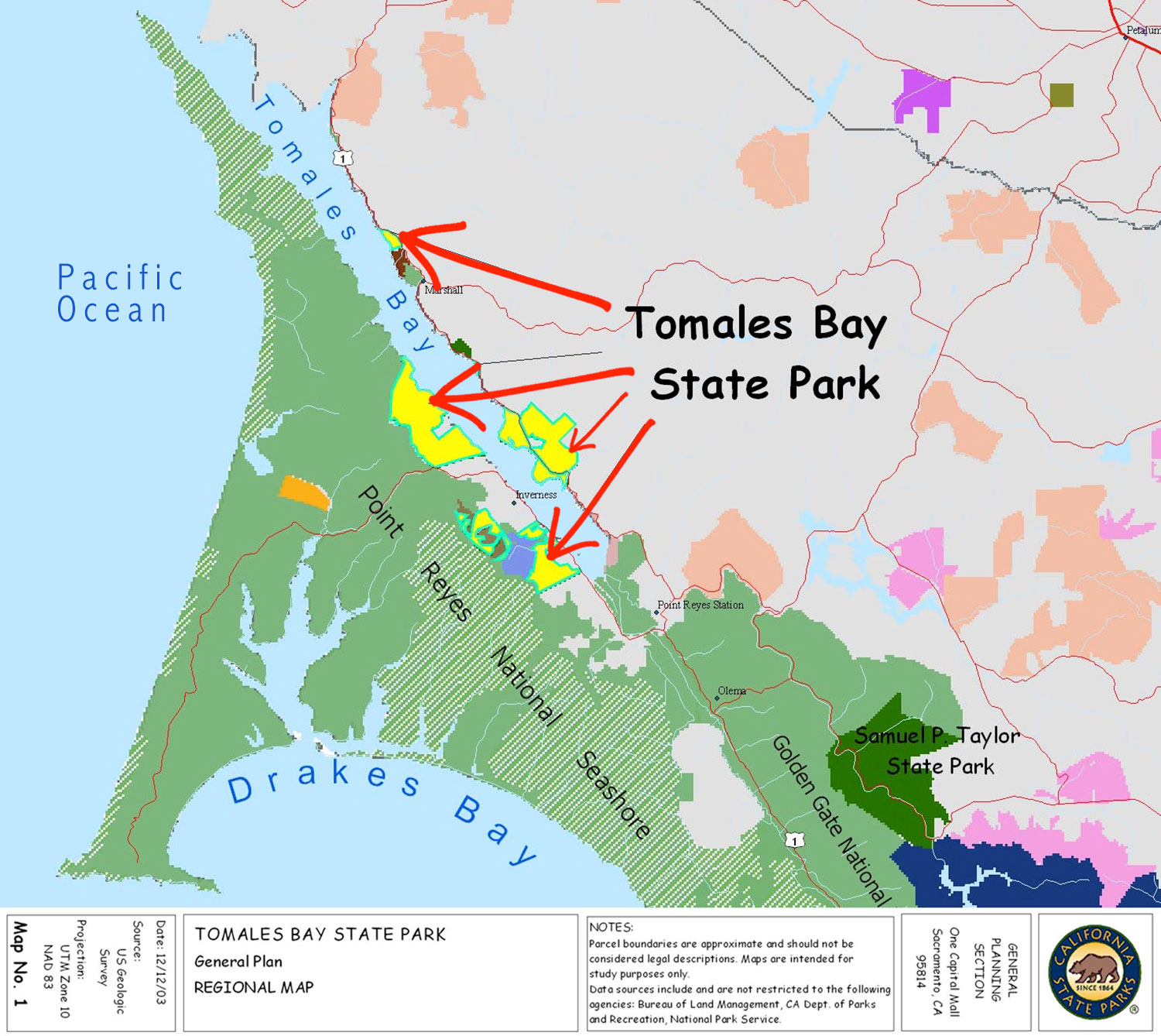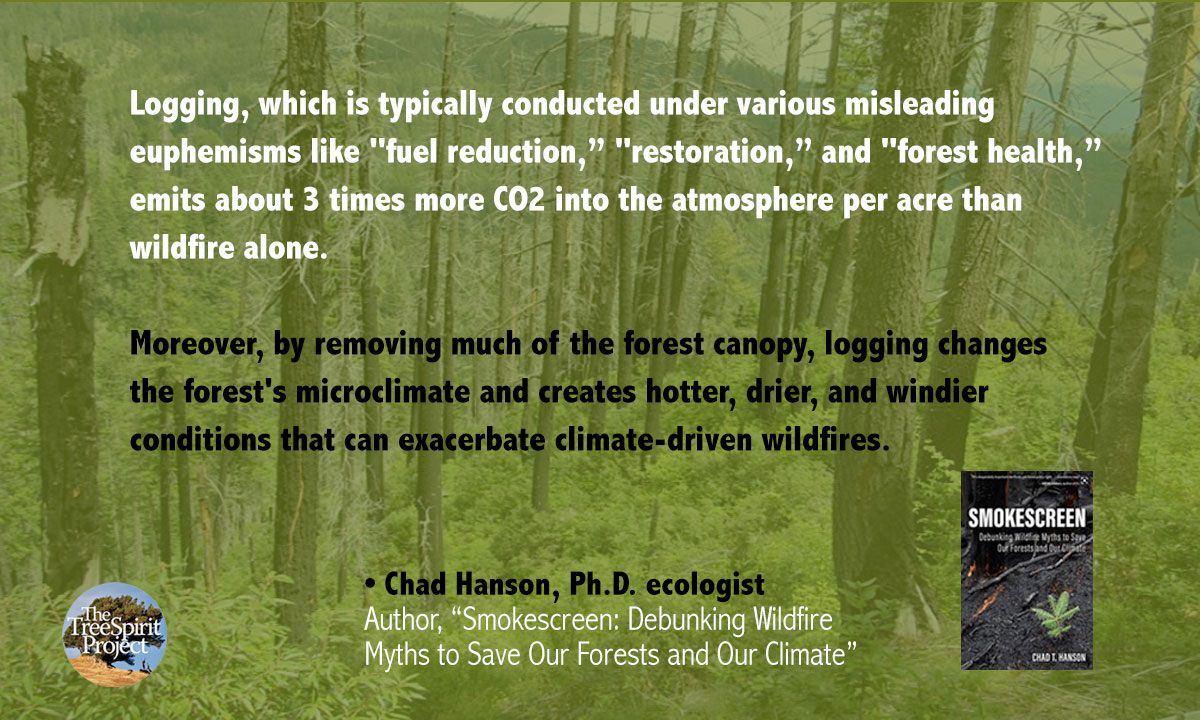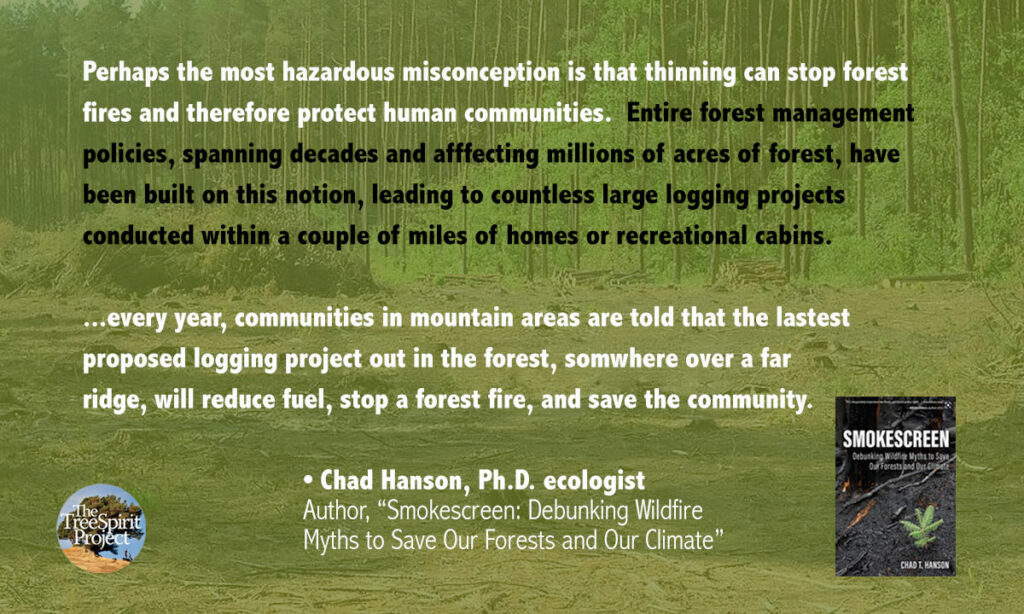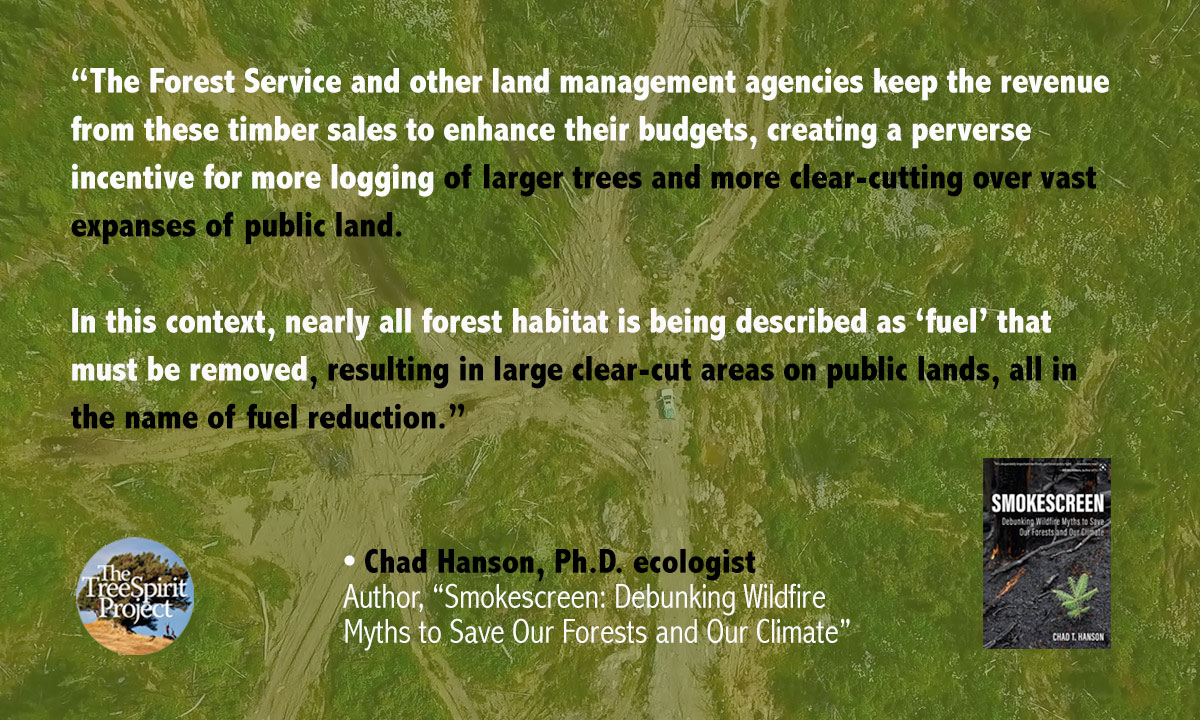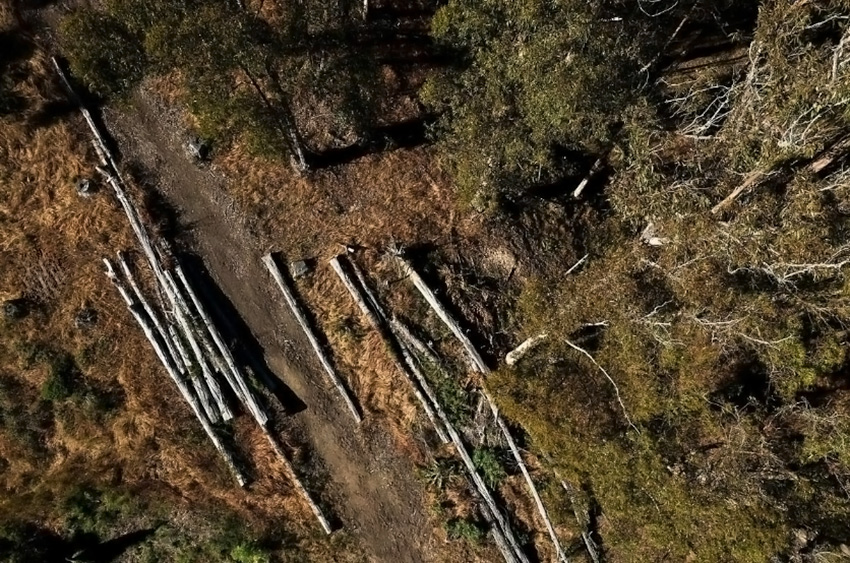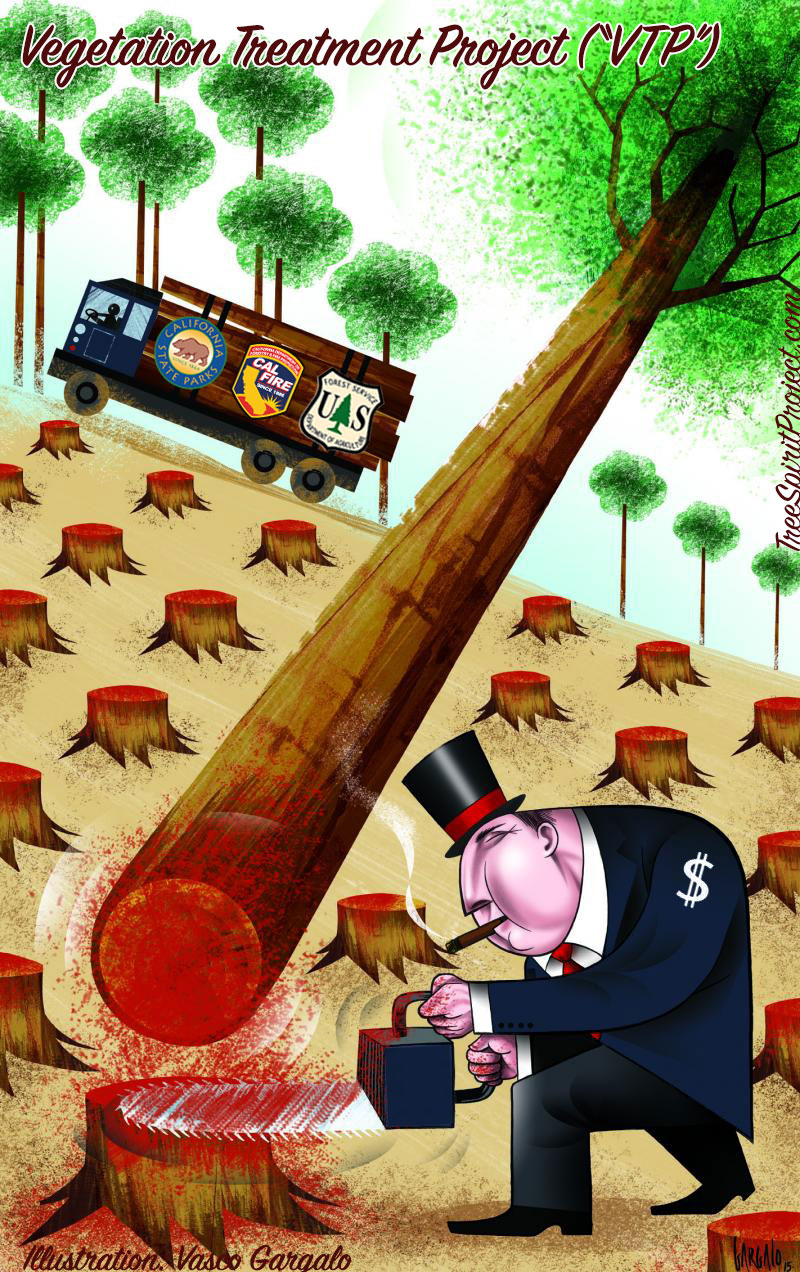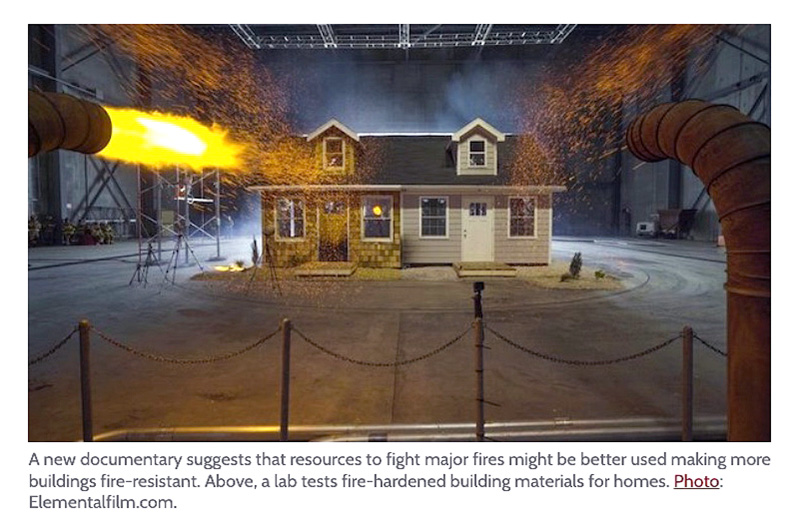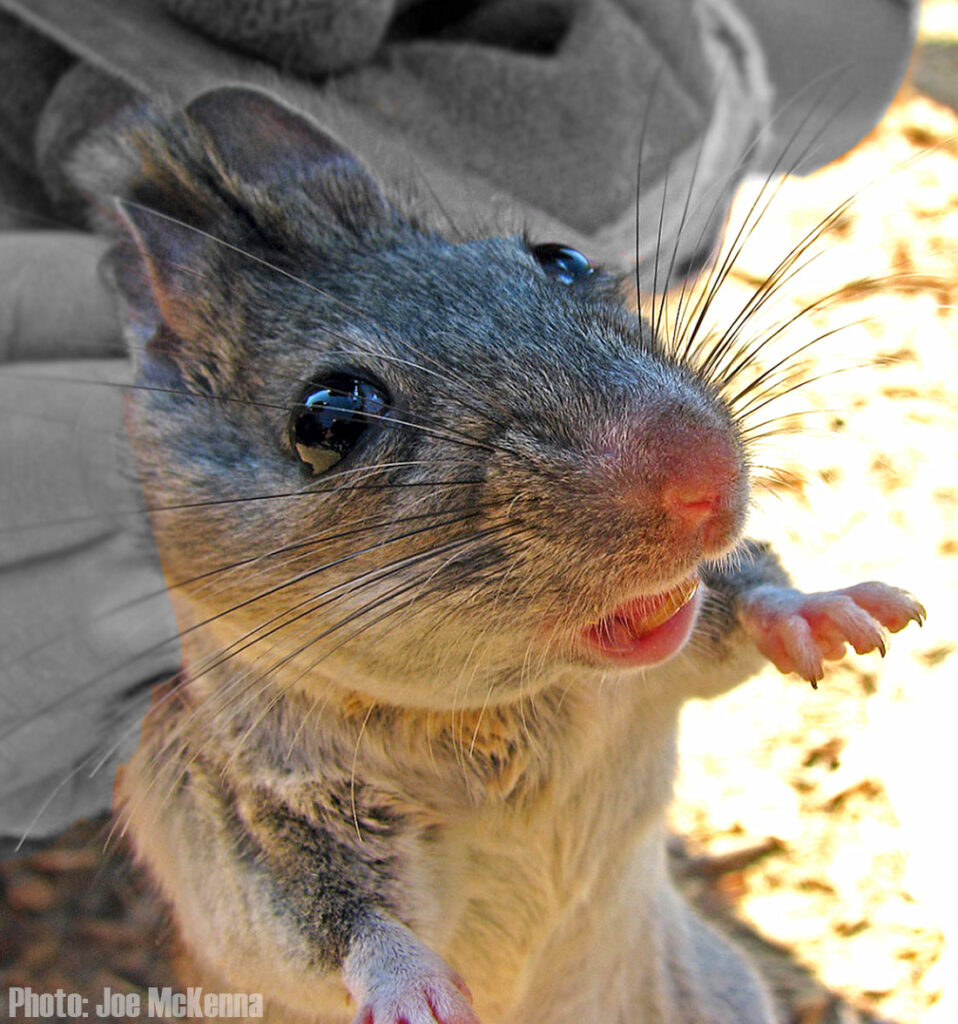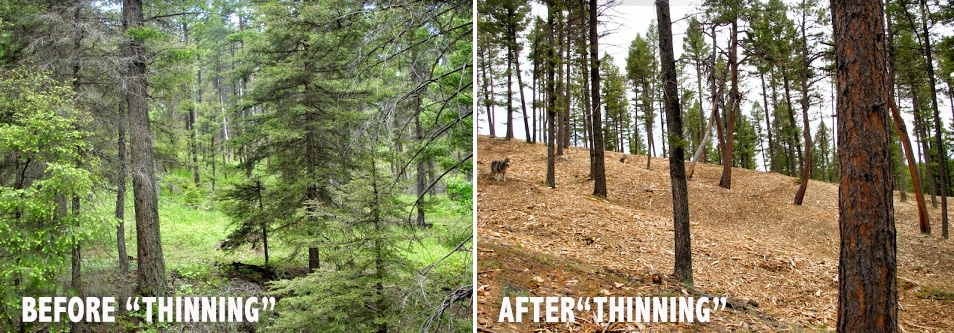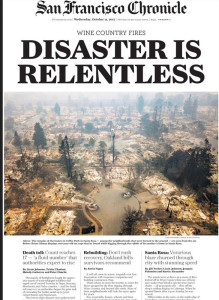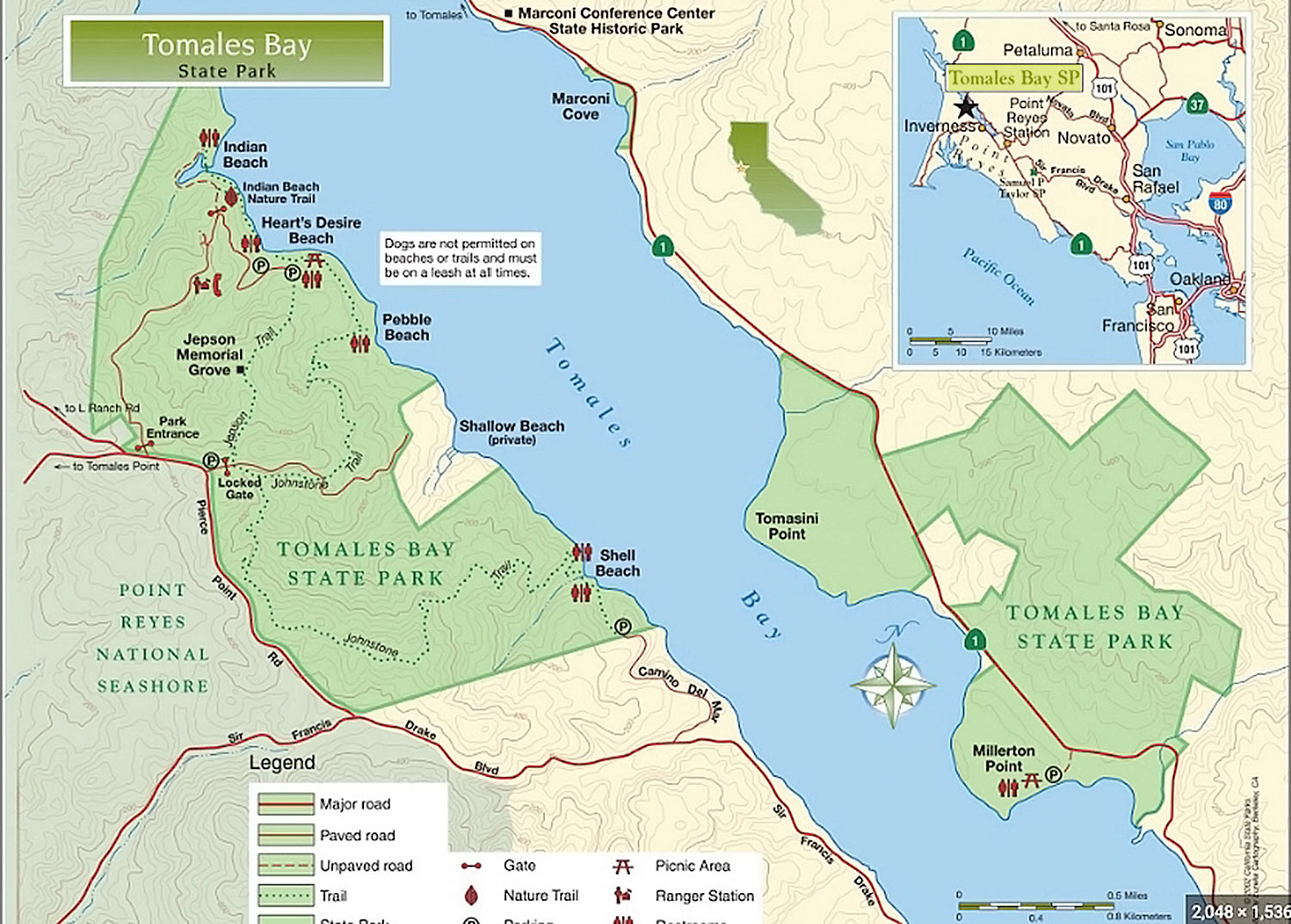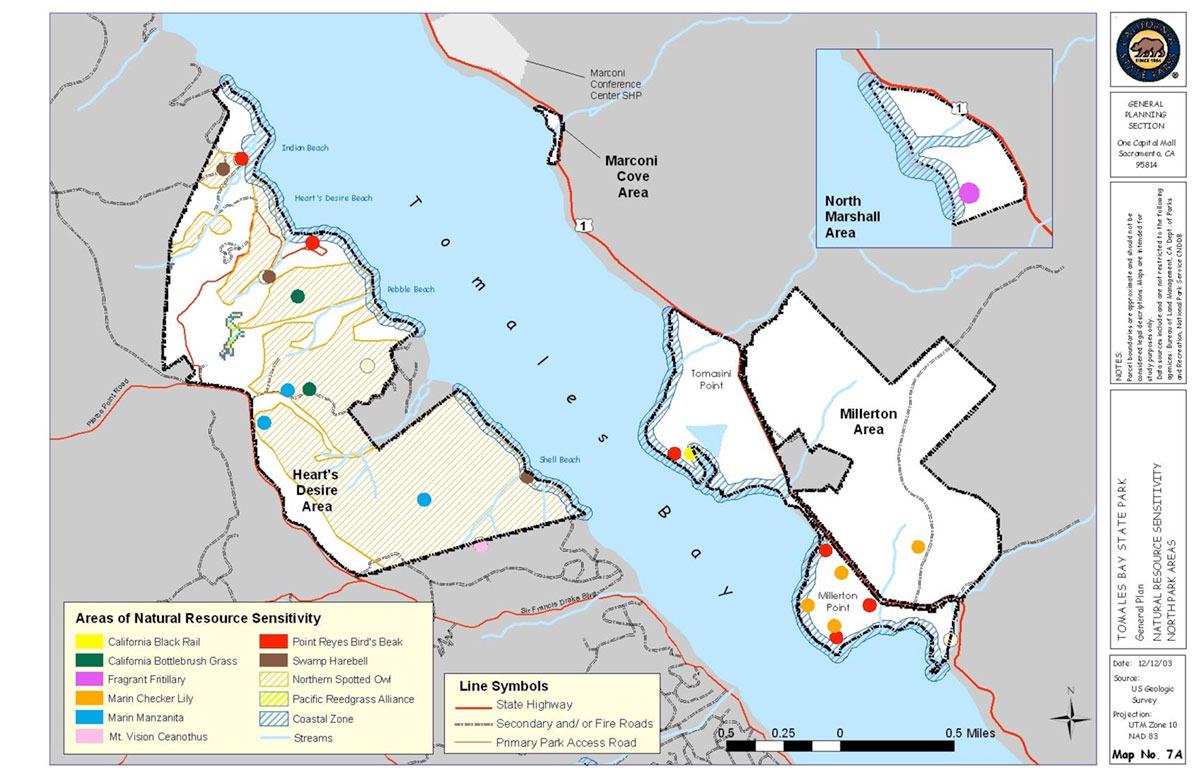“Slash, Burn & Poison” deforestation project.
Tomales Bay State Park, Marin County, CA
PLAY 90-sec. VIDEO (above) for quick overview: cutting up a forest in order to heal it.
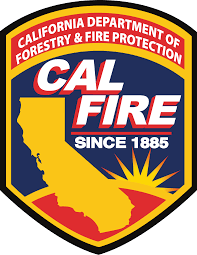
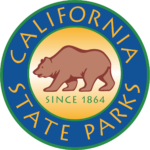 California State Parks (CalParks) and Cal Fire (The California Department of Forestry and Fire Protection), are on an ecological warpath. This Marin County, CA, forest is only the latest target of industrial forest “treatments” which include chainsaws, masticating machine, chippers and toxic herbicides like Dow Garlon and Monsanto Roundup .
California State Parks (CalParks) and Cal Fire (The California Department of Forestry and Fire Protection), are on an ecological warpath. This Marin County, CA, forest is only the latest target of industrial forest “treatments” which include chainsaws, masticating machine, chippers and toxic herbicides like Dow Garlon and Monsanto Roundup .
DENUDING A FOREST, INCREASING WILDFIRE DANGER
The Cal Parks (CA Dept. of Parks) “CalVTP” — “California Vegetation Treatment Project” — is targeting thousands of acres of wild forest in northern California, and chaparral habitat in SoCal, for “programmatic” destruction, while calling it anything but. Euphemisms to hide the truth of these wildland assaults include “thinning,” wildfire resilience” work, tree “removals,” forest “clearing” and “management.”
Cal Parks, along with Cal Fire (California Dept. of Forestry and Fire Protection) are chasing after millions of dollars in public funding which is available for any project claiming to reduce wildfire danger.
In Marin County, CA, just north of the Golden Gate Bridge, these agencies, turn public lands stewardship on its head. These supposed caretakers of forests and open space have the audacity to target even the dense, healthy, coastal cloud forest of Tomales Bay State Park (near popular Heart’s Desire beach). With Tomales Bay on one side and the Pacific Ocean a mile away on the other, it is one of the lushest, dampest forests in all Marin County. But this is literally a “forest-reducing” project because when its 10 years of industrial machinery have ceased their assault of tree-felling and the mastication of thousands of small bushes and shrubs, there will be hundreds fewer acres of forest left in its wake.
INCREASING WILDFIRE DANGER WHILE CLAIMING TO REDUCE IT.
The forest will be left more “open,” which means more open to the sun, more “park-like” and less of a wild, unmanaged forest it has been for centuries. The destruction of hundreds of healthy trees and thousands of understory shrubs will leave the forest hotter, which means it will become drier, which means it will become more prone to wildfire ignition. READ MORE ABOUT wildfire.
 But of course the agency uses the language of bureaucracy: “management” and “treatments” and “wildfire danger mitigation” and the biggest, baddest claim of all, the forest is referred to as a “fuel load.” A term which terrifies the surrounding community into supporting any proposed remedy, no matter how ecologically destructive and unsupported by third-party scientific ecological science. Only the potential benefactors of millions of dollars of state funds are themselves paid to determine the necessity of the industrial assault. (A good racket if you run it.)
But of course the agency uses the language of bureaucracy: “management” and “treatments” and “wildfire danger mitigation” and the biggest, baddest claim of all, the forest is referred to as a “fuel load.” A term which terrifies the surrounding community into supporting any proposed remedy, no matter how ecologically destructive and unsupported by third-party scientific ecological science. Only the potential benefactors of millions of dollars of state funds are themselves paid to determine the necessity of the industrial assault. (A good racket if you run it.)
This so-called “forest health initiative” (!) involves cutting down hundreds of trees both living and standing dead (aka, snags). Y’know, the trees which so many animals live in, to escape humans. And also destroy (masticate) thousands of understory plants of many species. And then apply the toxic icing on the layer cake of deforestation: herbicides. To kill even more plants, and inevitably poison soil, streams, insects, fungi, microbes and whatever animals are driven off in terror from the din of gas-powered tools.
READ 101 REASONS to oppose “chainsaw management” in Tomales Bay forests.
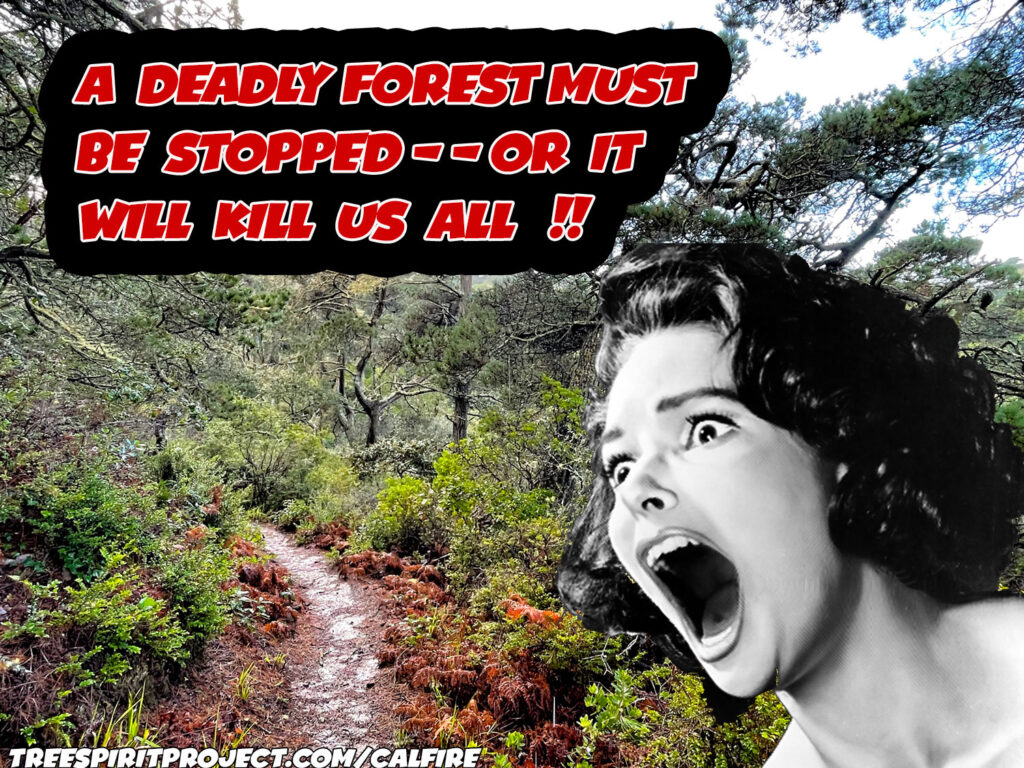
Simulataneously, the public is being sold the notion that chainsaws and masticators and herbicides will miraculously “restore” the health of aging Bishop pine trees in this mixed-species forest. Petroleum-powered machine tool “treatments” will also target some of the older pines, and chip downed trees which would otherwise retain water on the forest floor, grow fungi, and slowly decay. As forests do, and have done, for millions of years. This slow, natural decay deters wildfires by retaining water from winter rains and summer fog, making the forest damp while enriching and creating soil. This is exactly what forests when they aren’t “thinned” to become more “park-like” and open — and thus more inhospitable to animals too.
Killing trees and small plants with heavy machinery would not only emit large amount of carbon, but do double-duty ecological damage; dead trees and plants don’t sequestration carbon or produce oxygen.
This is a deforestation project which deploys Orwellian public relations Newspeak, to mislead and misinform the public. The forest-reducing assault is called a “health initiative,” despite doing the opposite of its name. Like with Peacekeeper missiles on the human battlefield, an industrialized War on Nature will bring Peace in the forest.
To qualify for some of California’s two billion dollars of wildfire prevention funds, the term “wildfire resiliency” is added — to describe felling scores or hundreds of trees. Cal Parks doesn’t estimate how many. Plus shredding hundreds of small plants with masticating machines. Cal Parks and Cal Fire (The California Dept. of Forestry & Fire Protection) simply, boldly, claim that slashing into a forest decreases wildfire danger — instead of actually protecting nearby homeowners by creating defensible space, hardening homes, and using other, less expensive and proven methods. READ MORE.
Burning piles of “vegetation” (killed, shredded plants) is justified by alluding to native American use of fire in forests. They neglect to mention that Coast Miwok’s did so to harvest food or flush animals out for hunting — not to reduce wildfire danger. The Cal Fire bureaucracy’s use of fire omits that both their techniques and objectives — getting funding dollars — are entirely different from how native tribes cared for land they lived on and relied on for food.
Saying the magic funding word, “wildfire,” can net tens of millions of dollars of California’s wildfire mitigation funds. These agencies need funding for projects to justify their existence. Tragically, slashing thousands of acres of forests in Northern California, and chaparral in Southern California in our time of climate crisis are what these agencies (Cal Fire, Cal Parks and the U.S. Forest Service, too) are hellbent on doing under the linguistic guise of “fuels reduction,” “management” and “wildfire resiliency.”
They do this by claiming that trees both living and dead, and thousands of smaller plants are a “fuel load.” And thus cutting them down and masticating them reduces wildfire danger. From this bureaucratic perspective, a new highway, dam or shopping mall project can be said to reduce wildfire danger; anything that “replaces” “hazardous” and “flammable” trees for “wildfire resilient” tarmac or concrete.
As a fictitious Fire Chief Lt. Calley might put it, “Sometimes you have to slash and burn down a forest in order to save it.”
READ 101 REASONS to oppose “chainsaw management” in Tomales Bay forests.
Tomales Bay State Park plans tree-cutting, burns
Forest management effort panned by environmentalists
February 19, 2023 by Will Houston
EXCERPT:
A group of environmental and advocacy organizations opposes the plan, stating that it is relying on overly broad forest management practices approved by the state and applying them to Tomales Bay forestlands without in-depth environmental studies.
The opponents say the work will disrupt the habitat of sensitive and endangered wildlife and plant species, dry out the forest floor and make the forest more susceptible to wind-driven fires. They also say the park should focus instead on maintaining fuel breaks and clearing defensible space surrounding nearby homes and communities.
“We do not think that basically clear-cutting native bishop pines is in any way mimicking the natural 200-year fire cycle,” said Laura Cunningham, California director of the Western Watersheds Project nonprofit group. “What we want them to do is leave the forest alone. It’s doing just fine the way it is.”
READ ARTICLE: https://www.marinij.com/2023/02/18/tomales-bay-state-park-managers-plan-tree-cutting-burns
Environmental groups challenge Cal Park’s claims that chainsaws, masticating machines and herbicides “restore” (Bishop pine) forest, or reduce wildfire danger.
EXCERPTS:
“The very purpose of acquiring the land to form Tomales Bay State Park involved preserving a subtle and refined visitor experience of the natural world that does not include prolonged chainsaw noise, clear-cutting of old-growth Bishop pine forests, herbicide spraying, livestock grazing, and violation of coastal cloud forests draped in hanging lichens and rooted with sword ferns, coffeeberry bushes, and hazelnut.
…chainsaws do not mimic the fire ecology of hot, high-intensity canopy fires that open cones to release seeds, as well as create an ashy, nutrient-rich bed for young trees.
No nursery stock would be brought from the outside; no Bishop pine seedlings would be planted. Targeted herbicide use would be considered.
We oppose herbicide use in state parks, and prefer hand-tool methods to remove invasive species.
Many regular park visitors have voiced extreme concern over this proposed project, which flies in the face of directives in the General Plan recreational, educational, and interpretive objectives.”
READ the environmental groups’ critical comment letter.
What is “masticating”? : killing hundreds of acres of healthy native plants, destroying the homes of birds and animals.
Destroying wildlands habitat is the new, fool’s gold standard of the logging industry’s old global-heating playbook. The same petroleum-powered, plant-killing “treatments” are regularly deployed by the U.S. Forest Service on federal lands (which are also owned by the public).
At Tomales Bay State Park, the public land is in a state park are supposed to be protected from these kinds of industrial land-scraping assaults. The way around them is to simply call them by different names, like “restoration” and “management” and wildfire “fuels reduction.”
For this western Marin County, CA, deforestation project in Tomales Bay State Park, about 30 miles north of San Francisco, it is state agencies wreaking the environmental havoc in healthy forests. The forests, and countless species of mammals, birds and plants and even soil will only suffer damage at the administrative hands of these state agencies.

This multi-million dollar project will kill hundreds of living trees, over a period of ten years, cutting down (“removing” is their euphemism for it) hundreds of standing trees, both old and dead, which are vital components of a healthy forest. Even long-dead trees provide bird, insect and mammal habitat. Even after dead trees fall, they feed the forest soils and hundreds more smaller forest plants and fungus and insect species.
Nature knows what she’s doing, thank you very much; she’s been perfecting her techniques for millions of years. By contrast Cal Parks and Cal Fire are propelled by the quest for millions of state funds earmarked for wildfire mitigation projects, so this one shoehorns in some of that justification.
State agencies getting their bureaucratic hands on state wildfire funds
The stated reasons for the Tomales Bay are: 1) improving forest health, and; 2) reducing wildfire danger — even though neither of these goals will be accomplished by felling trees and destroying literally thousands of understory plants, compacting soils with heavy machinery and then “treating” (another euphemism) plants with toxic herbicides which harm every organism they come into contact with. In this industrial land-scraping project, carbon-sequestering, shade-making, global-cooling forest will be ravaged.
Millions of trees are being cut down across California, both living and dead (but still natural, normal and necessary components of a healthy forest), under false premises. Make no mistake, this is deforestation during our climate crisis when all trees, and more trees are essential and indispensable. Fueled in large part by the public’s fear of wildfires, and further whipped up by media stories of “catastrophic” wildfires, Cal Fire has become a bureaucracy run amok, spending hundreds of millions of California’s tax dollars to kill millions of trees and plants, instead of actually protecting homes by “hardening” houses and structures against inevitable wildfires. In the process, these agencies are accelerating global heating, as well as landslides and even often increasing wildfire danger.
READ MORE about Cal Fire’s VTP (Vegetation Treatment Program) wreaking environmental damage in Southern California’s native chaparral habitat. The California Chaparral Institute has brought a lawsuit against Cal Fire for evading California’s Environmental Quality Act (CEQA).
Under the false guises of “reducing fuel loads” and “restoring” forest health,” bureaucrats and their agencies are destroying forests and other ecosystems, instead of “hardening” houses and structures — which would more effectively and less expensively reduce home and buildings “ignitions” by wildfires. READ MORE about the fallacy of Cal Fire’s destructive “fuel treatments.”
Millions of acres of native chaparral habit in southern California is also under assault by Cal Fire, grinding, burning and herbicide-spraying 1/2-million acres each year. Read this chilling, detailed description by the California Chaparral Institute: https://californiachaparral.org/threats/cal-fire/
Cal Fire now views trees as the enemy, and the enemy must be subdued, controlled, cut down, killed; words are contorted and distorted: “removing,” “thinning,” “treatments” and “restoration” sound innocuous, but all mean felling trees and/or destroying plants. Reminiscent of The Donald’s infamous, ridiculed and uninformed suggestion to “sweep” the forest floor to deter wildfires. But Cal Fire is worse , far worse because they’re not stupid; they intentionally mislead the public in their drive for industrialized forest “management.” Cal Fire’s doesn’t use brooms, but chainsaws, bulldozers, fossil-fuel-burning masticators and chipping machines in their “forest health initiatives.”
Cal Fire, and California State Parks, insist Gas-powered Gardening is the best way to save communities from wildfire, full-diesel ahead and damn the cost to forests. Many projects are reverse-justified with claims that these mechanized “treatments” will even restore forest “health” by “clearing out” understory “brush” and reducing “fuel loads” – – their Forestry Newspeak for forest plants and duff.
Large machines are right now destroying thousands of precious, shade-making, moisture-capturing, global-cooling trees, along with thousands more smaller understory plants, which are essential components of forests, creating healthy, moist, animal and bird-rich environments healthy, unmanaged forests are. These are distinctively different than manicured city parks which contain less life of kinds, including far fewer mammals and birds.
Call it state-sanctioned “industrial land-scraping;” a way to spend CA state coffers filled with wildfire funds approved by Governor Newsom. The public needs to know about this widespread destruction of our remaining forests, that it is only increasing wildfire danger, and contributing to the climate crisis. The enemy, as is so often the case, is us. But, as is also the case, when the people lead, our leaders will follow.
A June 2021 San Francisco Chronicle article diplomatically address this ecological assault:
Newsom’s wildfire plan may have a problem when it comes to fighting big blazes
June 20, 2021 by Kurtis Alexander
EXCERPT:
Before last year’s devastating fire season, Gov. Gavin Newsom directed firefighters to clear huge lines of trees and shrubs near more than 200 communities to help stop or slow a potential blaze. Much of the work was done in the Bay Area.
These widely promoted fuel breaks, a centerpiece of the governor’s billion-dollar strategy to protect California from catastrophic wildfire, however, have had limited success, according to data reviewed by The Chronicle.
While state officials credit some of the breaks with helping contain fires, relatively few of the projects have been in locations that burned. When they did intercept a fire, the flames often pushed right through, governed by winds and ember storms made famous in the destructive infernos in Paradise and Wine Country. Going forward, the breaks are likely to have similar shortcomings.
Fuel breaks are all slightly different, but they’re generally strips of forest or scrubland where vegetation has been cut back to reduce fuel for a fire. The idea is that when a blaze hits the break, it eases up, giving firefighters time to move in and take a stand.
“Fuel breaks generally don’t work when it matters most,” said Bryant Baker, conservation director for the environmental group Los Padres ForestWatch, who has been examining how the state’s projects affect fire behavior. “The fires just completely overrun the fuel breaks, especially under extreme, windy conditions. And these extreme fires are the ones we need to be concerned about, the ones that are doing most of the damage.”
The breaks can take months, if not years, to build, and cost hundreds of thousands of dollars or more. Some breaks may be just a few dozen feet wide while others can be hundreds of feet wide and stretch for miles, comprising tens of thousands of acres. Fire agencies as well rural communities and neighborhood groups have been building such defensive lines for decades.
READ ARTICLE: https://www.sfchronicle.com/california-wildfires/article/Newsom-s-wildfire-plan-may-have-a-problem-when-16260902.php
U.S. Wildfire Response Badly Off-Base, new documentary film, “Elemental,” shows
 October 12, 2022 by Robert McClure
October 12, 2022 by Robert McClure
EXCERPTS:
Directed by filmmaker Trip Jennings and produced by Oregon attorney Ralph Bloemers, [the new, 2022 documentary film] “Elemental” definitely has a point of view and a policy prescription… It’s also clearly a work of solid journalism, based on deep research, with an urgent message: We’re doing this wildfire thing all wrong.
“We’re not gaining. It basically tells us, in boldface, that we’re going in the wrong direction,” says Jack Cohen, veteran researcher from the U.S. Forest Service’s Fire Sciences Lab in Missoula, Montana, in one scene.
Importantly, the film shows two politicians from the West, with a D and an R behind their names, promoting the long-standing idea of selective thinning of “overstocked” forests. And the film shows how that mindset doesn’t match the modern reality.
…[the first of] three principal takeaways from the documentary is that we are not going to be able to thin forests fast enough or prescribe-burn our way out of this. There’s just too much forest out there.
One study showed that only 1% of lands that were thinned and/or burned later experienced fires — it’s hard to predict where fires might occur. And even when those “treated” areas later became engulfed in a big fire, they very often proved ineffective as fuel breaks to slow or stop the fire.
“The idea that we can fireproof this huge landscape of flammable material is simply an impossible task,” Colorado landscape ecologist Tania Schoennegal says in the film. “It’s like trying to scoop out water out of the ocean to make it less wet.
My second takeaway is that the money we are now pouring into what critics call the fire-industrial complex would be better spent protecting buildings from fire, rather than trying to contain most major fires.
My third takeaway — and the one most important for my current reporting — is that our present approach is a really bad deal for the climate.
The long-prevailing assumption that older forests are sources of carbon, or at best are net-zero, is just wrong. Measurements by Law and others show that.
“We found that these forests are much more important than people imagined,” Law says in one scene. “Mature and old forests are the workhorses. They take up more carbon annually and they have a lot more stored in the wood” than younger forests.
READ REVIEW: https://www.sej.org/publications/ej-insight/us-wildfire-response-badly-base-new-doc-convincingly-shows
Wildfires renew and restore life
VIDEO: “The Fire Paradox”: “The more we try to remove fire, the worse we make it.” – Mark Finny, research forester with the U.S. Forest Service.
Wildfire is a powerful, primal force, and an integral, healthy, unavoidable component of a natural forest ecosystem. But we have a complex relationship with this force of nature, especially today with wildland fires near houses, towns and cities that increasingly encroach on dwindling wild forests, chaparral habitat, and other wildlands that are now increasingly being “managed” to death.
Misinformation & misconceptions: spreading like wildfire
Many people have been trained, especially by sensationalized media coverage, to think all wildfires are purely “destructive” and “disasters” that “destroy” — and therefore must always be prevented and extinguished, especially if anywhere near people and their homes. Until recently, even most contemporary scientists supported this inaccurate, and ultimately futile view: more homes have burned to the ground despite firefighting efforts.
Again, as is emphasized on this webpage and this website’s pages, we don’t need to stop fires or cut down trees and forests in order to save our homes from burning down. And we can’t. Instead, simply, less expensively, and more effectively, and also less expensively, make houses “ignition resistant” in the “home ignition,” from the home-out.
VIDEO: U.S. Forest Service “FIRE LAB” researchers Jack Cohen & Mark Finney
Cutting down forests does not “save” them
So-called forest “thinning” (i.e., logging) INCREASES fire danger.
Cutting down 20-70% of the trees — called “thinning” by the logging industry — dries out what’s left of a forest, allows wildfires to be more wind-driven, and destroys soil health and animal habitat. Numerous hidden agendas propel the terrifyingly widespread policy of deforestation, as with the California State Parks plan to “remove” hundreds of trees and thousands of shrubs in Tomales Bay State Park, referenced above.
These ecologically devastating projects are usually advanced with either of both of two false claims: 1) “restoring” forest “health; and 2) mitigating wildfire danger by reducing the “fuel load” — and “fuel” is trees and plants! With this ill logic, all forests could be targeted for destruction, or “removal,” as bureaucracies and industries call killing trees, despite often being couched in detailed, pseudo-scientific jargon.
READ MORE on TreeSpirit’s WILDFIRE PAGE
Media sensationalism fuels fear of forests
News outlets typically cast forest fires as destructive villains that “destroy” everything in their wake, including forests, and therefore must be prevented. Of course wildfires can do great damage, destroying peoples’ homes and taking lives, as in huge California wildfires in recent years.
But wildfire is inevitable and unstoppable because it’s an essential component of nature. Fire regenerates a healthy forest ecology, clearing the ground of other plants, many of which are evolved to survive fires too. Many trees and plants, including in California, are serotinous, meaning heat opens a tree’s cones and/or seeds, enabling plant germination. In short, forest fires are necessary, valuable, and irreplaceable.
VIDEO: An unspoiled forest home for thousands of creatures.
MAPS of Tomales Bay State Park, west Marin County, CA

